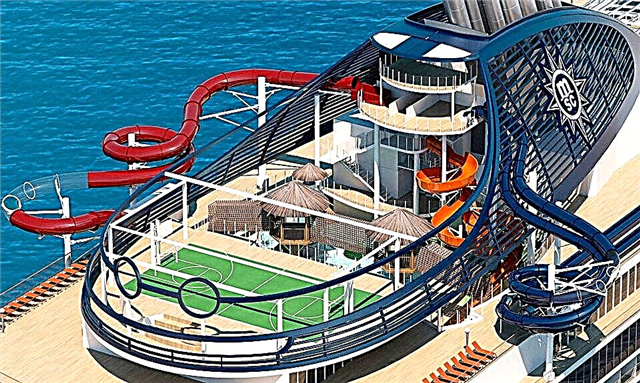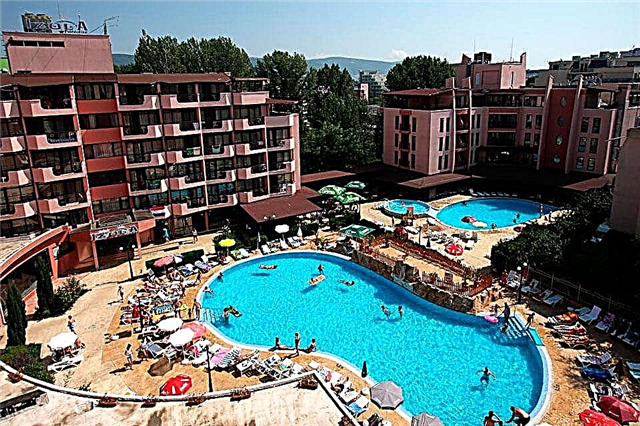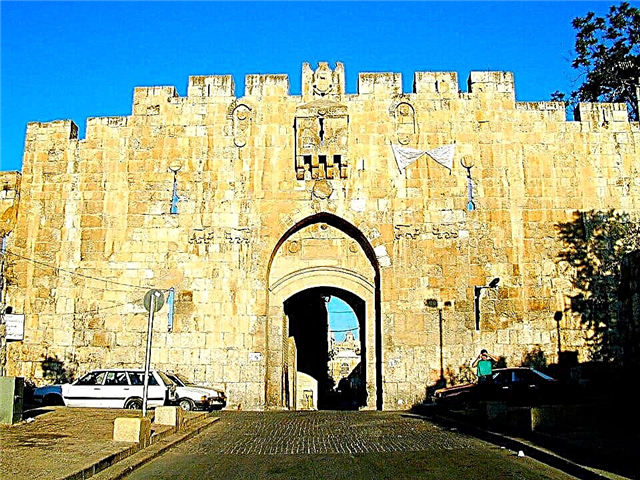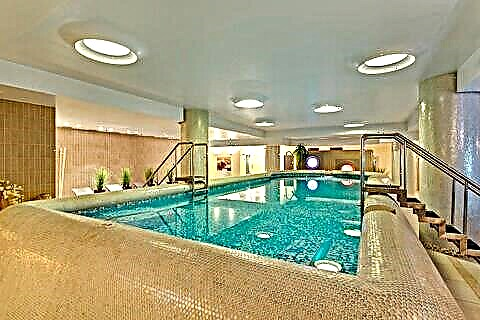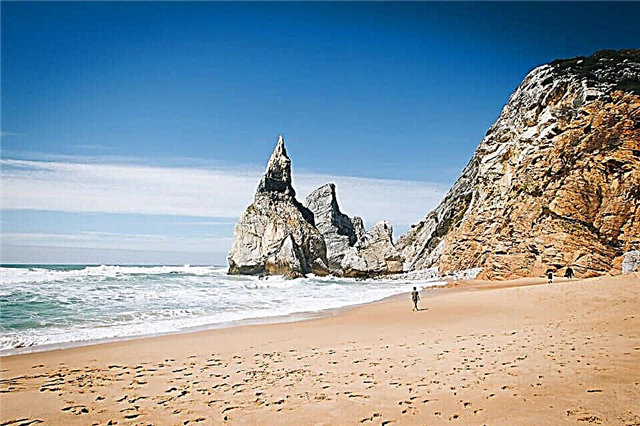The country of great seafarers, travelers and famous football players occupies the westernmost part of the Iberian Peninsula. The whole world knows the names of Vasco Da Gama, Ferdinand Magellan, Cristiano Ronaldo, Jose Mourinho and others. Filled with the sun, generously rewarded with gifts of nature, caressed by the Atlantic, Portugal is a large open-air museum. Hundreds of ancient sights in different cities are objects of pilgrimage for tourists. By the nature of the landscape, the country is divided into 2 parts - a mountainous northern and a flat southern, the border of which is the valley of the Tagus River. Portugal's subtropical Mediterranean climate and stunning beaches make it a popular seaside resort. In addition to the coastal resorts of the mainland, it is famous for the elite island resorts of the Canary Islands and Madeira. The beaches of Portugal are particularly picturesque and natural originality, admission to them is free everywhere.
Magoit

This coastal strip of land stretching along the ocean for 800 m is not an ordinary beach, but a unique natural formation that is part of the Sintra-Cascais National Reserve. Magoitu amazes the imagination with a ridge of petrified sand dunes, furrowed with deep "wrinkles" due to the winds. Such unusual dunes are a real geological unique, created by nature over the millennia. Next to the dunes is the main entrance to the beach. The surprises do not end there: in the southern part of Magoitu, gray-black rocks rise close to the water's edge, contrasting with the yellowness of the sand.
In the northern part of the beach, on the slope, there is a wooden flooring with steps that zigzag down to the water. A coniferous forest has grown around, ozonizing the sea air. The forest is well-groomed with cozy picnic areas. At low tide, giant relic strata are exposed in this part of the coast. Of great interest to tourists is the staircase, laid in a vertical tunnel, once cut down in a 20-meter-high cliff. On it today fishermen descend to the sea. Magoitu is very popular with tourists not only for its unusual landscape, but for its healing air and excellent infrastructure.
Azenyas do Mar

In the famous wine region of Portugal at the confluence of the river into the ocean. Ribeira do Cameijo is a village with the beach of the same name. The name of the village and the beach comes from the Arabian watermills (azenyas). This slice of the Lisbon coastline is extraordinarily picturesque. Dazzling white houses with tiled roofs, successively descending to the water, adorn the high cliff. The white foam lace of the surf in a wide ribbon surrounds the rocky walls.
But the beach itself is 30 m long. As such, you can find it only at low tide. Moreover, the "image" of Azenhas do Mara is constantly changing under the influence of ocean waves: the layer of sand after winter storms is increasing, then decreasing. A long staircase with gentle steps leads to the beach along the river. The pool is amazing here, carved into the rock and filled with water at high tide. Directly above it there are open terraces of the restaurant of the same name, which tourists love to visit.
It serves a unique variety of red wine with a tart, salty taste (a visiting card of these places). Local sandy soils with a special composition protect grapes from phylloxera diseases, so the wine is very much appreciated by gourmets. The beach strip is devoid of any infrastructure - after swimming, many are located on the site around the pool.
Ursa

Probably, there will not be a person among travelers who would not express admiration for one of the most beautiful Portuguese beaches with the name Ursa (she-bear). It simply could not be ignored by the legends associated with the geological metamorphoses of the Earth. According to one of them, millions of years ago, when everything was covered with ice, a bear with cubs lived here. The ice began to melt, and the gods called upon the animals to leave the ocean, but they remained on their native land, for which the angry gods turned them into rocks.
Ursa is a wild beach that is quite difficult to get to. A kilometer-long dirt road leads directly to it - you can get there either on foot or by SUV. The descent down goes along 2 paths, the left one is much more convenient and safer. The wild beach will justify all the difficulties of the path: the mesmerizing beauty of the bizarre rocks against the background of the ocean blue makes you freeze with delight! Behind the "bear" rock there is a giant arch hanging over the sandy strip. Attention is drawn to the waterfall formed by the river, a small cave and a cove strewn with stones.
Masash

The Masash (apple) beach is located 13 km from Sintra, near the settlement of the same name. The village and the beach got their fruit name in connection with the apples brought here by the course of the Masash River, along the banks of which apple orchards grow. The wide and long beach is a favorite vacation spot for Portuguese and foreign tourists. They are attracted by the charming authenticity of the surroundings. When you come here from Sintra, you are transported to the era of the early 20th century. A narrow-gauge railway, laid in 1904 along the side of a mountain among a dense forest, an old tram is a real magic.
Masash nestled comfortably between low hills and a settlement that protected him from the wind. Entry into the water is gentle, comfortable, so it is good to have a rest here with children. There are excellent conditions for active pastime: there are tennis courts, a football field, a park with children's attractions and benches. There is a rental point, showers, changing rooms, lifeguards are on duty. The only negative is the presence of stones on both sides of the beach. The village has a choice of apartments, a cafe with national cuisine for those who come here for a few days.
Costa da Caparica

The Setubal Peninsula cannot be called anything other than a beach paradise - 30 km of its west coast is a continuous sandy strip. The beaches of the Costa da Caparica resort occupy 8 km of the coast, and this is only the equipped part of them. Wild coastal areas continue further. Thanks to the influx of tourists here, the former fishing village has turned into a thriving resort with highly developed infrastructure.
There are no clear boundaries between the 21st beach area, you can navigate by the name of the station of the tourist train coming from Lisbon. The best beaches have been awarded the Blue Flag and international quality medals for their cleanliness. But almost everywhere everything has been created for an excellent civilized recreation of holidaymakers. The first of the northern beaches, the widest and longest (3 km), stretches along the city. There is a bicycle path and a pedestrian promenade.
In the spring, when the trees in the nearby grove bloom, the air here is filled with fragrance. The next 6 beaches with a narrow strip near the city limits are also picturesque, well-groomed, and attract the attention of not only tourists, but also local fishermen. Their multicolored boats stand off the coast at low tide. The remaining 14 sections of the coast lie outside the city, some of them are limited by dunes, replaced by forest. In this kingdom of sand and water, everyone can choose their own piece of happiness.
Assenta Sul

The wide sandy and pebble strip of the southern beach of Assenta Sul is more of a contemplative object than intended for swimming and other beach activities. This place attracts tourists here with its amazing landscape. A high rocky coast, overgrown with grassy vegetation, a lovely cascading waterfall falling on mossy stones create a rather picturesque picture. Despite the fact that there is some infrastructure, swimming, surfing is excluded here due to the low water temperature (+18) and the presence of large stones along the coast.
Assent Sul has no rental offices, no rescue services. There is a mini-bar, several areas for vacationers are open.Tourists walk to a small lighthouse along the road leading to the village of Assunta. At the coast, the road ends with an extensive parking lot and an observation deck at the same time. There are comfortable benches, sitting on them, you can observe the majestic panorama of the ocean and the surrounding area. There are more fishermen on Assunta Sul than tourists, judging by the presence of several hangars for boats and fishing outbuildings.
Alges

Located on the Lisbon Riviera, a 250-meter strip of yellow-gray sand is the beach of Alges. Today, looking at a sparsely populated space, it is hard to believe that until 1965 it was a very busy place, teeming with people. But that all changed with the commissioning of the bridge leading to the Costa da Caparica with a huge number of beaches. Tourists and Lisbon residents rushed towards them, ignoring the nearest beach.
But lovers of secluded relaxation still prefer the cozy strip of Algés, surrounded by fishing docks. A thick layer of soft sand, clear turquoise water with fine waves allow you to enjoy a relaxing holiday. A small breakwater protects against strong waves. Everyone comes here with towels or mats - there is no beach infrastructure. A Mexican restaurant is located at the edge of the sand.
Kruzh Kebrada

The indescribable beauty of the coast of the Portuguese Atlantic is undoubtedly complemented by the sand and pebble strip of the Kruj Quebrada beach. It is located in the suburbs of Lisbon within the boundaries of the village of the same name. Translated Kruzh Kebrada sounds like a "broken cross". In confirmation of this, a wooden cross from the 12th century, damaged by lightning, is installed next to the beach. The rarity is carefully tied with metal pins and is quoted as a monument. Kruz Kebrada can hardly be called a lively tourist attraction.
There are more Portuguese fishermen here, with many boats and tackle kept on the shore. There are no sun loungers, umbrellas, lifeguards are not on duty. Admirers of semi-wild rest are happy to spend their leisure time admiring the blue ocean and white wings of sailing boats. The sports complex, located nearby, attracts vacationers. It has a stadium, swimming pool, tennis courts and a golf course. In the middle of the beach strip there is a river, through which 3 bridges are thrown: a railway and 2 automobile bridges. One of the motorways is crowned with 17th century Roman arches.
Kashias

1.2 km from Lisbon, there are 2 ancient forts located on both banks of the Tagus River, which flows into the Atlantic Ocean. Under their "protection" is the Kashias beach, covered with golden yellow sand. It is very convenient to get to it from Lisbon by train or electric train, stopping in front of the beach. 17th century forts in the baroque style is the main tourist attraction of this place. One of them, San Bruno, built in the shape of a star, is especially beautiful. There are jogging and cycling paths along the beach strip.
Between Fort San Bruno and the Autobahn is a small square with a restaurant and parking. The palm alley, green lawns with lush grass look very picturesque. Restaurant guests are located indoors, under a covered canopy and on an open terrace. The entrance to the water in the district of the 1st fort is convenient sandy, but next to the 2nd fort it is rocky. At low tide, shrimps and nimble crabs can be seen between the stones. There are sun loungers and umbrellas made of palm leaves, lifeguards are on duty, vigilantly watching the rest.
Santo Amaro de Oeiras

This stretch of coast, located in the vicinity of Oeiras, is very popular with Lisbonians and tourists. Santo Amaro is considered to be the best large beach on the Lisbon Riviera. It has everything that can decorate your vacation: rental of surfing equipment, catamarans, a restaurant, a bar, sports grounds. During the swimming season, there is a rescue and medical service, at night the strip is lit with electricity. From the embankment to the beach, they descend along convenient ramps. A strip of sand 760 m long is perfectly clean, the water on this section of the ocean is without strong waves - side breakwaters protect them from them.
The shallow waters off the coast at a distance of 15 m attract parents with small children here. Here you can enjoy not only beach pleasures, but also unique attractions. In the center of the mouth of the river. Tagus has an islet with a round fort and a lighthouse. On the eastern side of the strip is the fort, which today houses the Portuguese Navy's summer camp. This is an architectural monument in the style of Mannerism, with an interesting interior design. On the western side, Santo Amaro is bordered by the yacht marina Oeiras and 2 forts of the 17th-18th century.
Torre

Another beach in the vicinity of Oeiras is named after the tower of the 16th century fort of São Julian da Barra. The fortification building, designed by the famous architect Vauban, is an outwardly inaccessible structure. It was not by chance that he was chosen as the seat of the Portuguese Ministry of Defense. The fort is closed for visitors, only external sightseeing is possible. Torre is the best place for swimming with constant monitoring of the water quality.
The monolithic walls of the fort and the harbor pier reliably protect the ocean from the waves. The entry into the ocean is shallow, the bottom is sandy, so the main contingent of holidaymakers here are families with children. Local residents and tourists from neighboring resorts come here. The area of Torre is very well maintained and equipped with excellent infrastructure. There are plenty of sun loungers, umbrellas, toilets and showers. An interesting bar, equipped in an old railway carriage. There is a restaurant with an outdoor terrace. On the other side of the fort is the harbor, crowned with an original monument in the form of a huge whale tail.
Azaruzhinya

When you first visit Azaruzhina, you find yourself in the atmosphere of a fantastic world. A solid wall of monolithic rocks, similar to an ancient amphitheater, surrounds a small patch of sand. At high tide it is almost completely flooded, leaving only a narrow strip in the central part of the beach, surrounded by stone slabs. They go down to it along 2 steep stairs, laid along the slopes of the rocks. On the other side, the entrance to the beach is from a concrete embankment that stretches along the water's edge for 3 km.
City buildings, a palm alley approaching the edge of the rocky wall look picturesque. There is an opportunity to rent umbrellas at Azaruzhin, there is a first-aid post and a rescue service. On the west side of the strip, there is a popular bar surrounded by a platform with benches. Here you can relax, quench your thirst with drinks and admire the unusual landscape. On the east side is the Fort Santa Antonio da Barra (16th century). But you can approach it only through the city, there is no way along the coast.
Posa

A strip of sand 200 m long, located 500 m from the famous Tamarig Beach, like many of Lisbon's beaches, is very picturesque. And for the purity of the water, Posa was awarded the Gold Medal. To it, unlike other places, the access is easy, from the side of the embankment. But swimming is allowed here only in the central part, as there are stone piles on both sides of the sea that pose a danger to bathers.
The eastern part of the beach is quieter and more peaceful - it is protected from land by a high rocky wall. The grandiose building of Fort Cadaver, a 17th century monument, is based on it. After a recent restoration, it was turned into a children's summer camp. As in the entire Atlantic coast of Portugal, the water here, even in hot months, does not warm above 20 °. Comfortable conditions for rest have been created on the strip. There is a rental of equipment for surfing, snorkeling, showers are equipped, a restaurant and bar are open, lifeguards are on duty.
Moytash

It is hard to go wrong when looking for a small stretch of the sandy Moitash coastline. An excellent landmark is the huge glass building a la modern next to the beach. A strip of fine, soft sand, shaped like an elongated triangle, is separated by a breakwater that goes into the sea for 100 m. Moitash is regularly awarded the Blue Flag for its ecology.The whole urban environment of these places looks very attractive. Interesting to visit, for example, is the museum housed in a 19th century mansion. neo-gothic style.
Although swimming here cannot be called comfortable, there are always a lot of people on Moitash. The presence at the bottom of stones exposed at low tide is compensated by a natural stone pool filled with water at high tides. It warms up well, and after swimming in the cool ocean, many go to the pool. Here is the freedom for those who are engaged in windsurfing, diving, snorkeling - the wind is a frequent visitor to Moitash. Excellent arrangement of the beach, ecological cleanliness attract people of different ages.
Tamariz

Between Lisbon and Cascais is the town of Estoril, which has received resort development thanks to the famous Tamarig beach. The wide sandy strip attracted the attention of beachgoers long before its improvement. And this gave impetus to the rapid development of the city. Today, it houses the world famous Estoril casino opposite Tamarizh. Many beautiful buildings surround the embankment.
An infrastructure has been created here that is not inferior to the level of the best world resorts. The only negative is the lack of paid parking spaces. Tamaris is the first beach in Portugal to be awarded the Blue Flag in 1987. Since then, this award has been awarded annually to the site, along with the Gold Medal for Water Quality. The sandy strip (300 m) in the center is divided into wide and narrow parts by rocks.
The eastern section is fenced off by a 100-meter breakwater protruding from the embankment into the ocean. It provides a calm water surface. On the other side of the pier there is a natural pool, and a little further there is a wild rocky beach. There are 2 paid swimming pools in the western part of Tamarizh, the reference point to them is the Church of Santa Anthony of the 18th century. Tamarizh has everything for a comfortable stay, even places for wheelchairs.
Paso de Arcos

The beautiful Portuguese town of Paso de Arcos, part of the municipality of Oeiras, is famous for the beach of the same name, which was the first to be landscaped in Portugal. Today it is divided into 2 halves - new and old. The first one is 250 meters long and is ideally equipped with the necessary attributes of a comfortable sea holiday. During the swimming season, there is literally nowhere for an apple to fall - it is very crowded. Young people, the elderly, couples with children choose this beautiful place.
A charming city garden with the ruins of an ancient fort complements the scenic beauty of Paso de Arcos. Parts of the beach are separated by the buildings of the Sailing Center and the area of the Lighthouse Directorate which is closed to the public. The old part of the beach strip, protected from the river by a pier of 150 meters length, is occupied by fishermen. Their fishing tackle and boats are picturesquely scattered throughout. Nearby, 20 meters from the shore, a geyser fountain gushes out - an attractive sight especially when it is illuminated by lights.
The western side of the Paso de Arcos ends in a narrow strip of stones. It is interesting to walk along it with a research purpose. Here you can see small pools, an interesting bridge-Roman arch, laid to the rock. It contains a strange structure with walls dotted with abstract graffiti.
Foj do Sisandro

A sandy area of a curved shape, washed on one side by the ocean, on the other - by the river of the same name - this is Foj do Cisandro beach. There are two paths to the sandbank: via the nearby Azul beach or via the footbridge from the village of Foj. True, the bridge is accessible only in summer, at low tide. With the autumn tide, it disappears by half under water. Even in summer it is not very crowded here, because the water temperature rarely reaches + 20 °.
In this place, strong winds often blow, and big waves are in the hands of surfers. On Fozhe there is a rental office for equipment for water sports, including fishing. There are showers, a parking lot, security guards are on duty. There is an opportunity to dine at a local restaurant, cool drinks in the bar. A shallow lagoon forms at the confluence of the river into the ocean. The water in it warms up well, and children usually splash in it.
Santa marta

When you first get to this amazing place, you immediately realize that Santa Marta is not a standard beach. Nobody swims here, there are no sun loungers and umbrellas, no sanitary control. Visitors are attracted here by a truly unique environment, as if resurrected from the fairy tales of the Brothers Grimm. An ancient Roman bridge with a stream flowing under it, an ancient palace with ivy winding along the walls create a magical picture.
A sandy piece of the beach itself is located at the end of a narrow bay. A pool is formed on it, fenced with stones. At high tide, the water rises to the walls of the palace, which once belonged to the Count of Castro. The yellow walls of the picturesque building, the stone tower with the Gothic roof are very impressive. Today it is a museum displaying a collection of the Count's belongings. Next to the current lighthouse is the building of the 2nd Museum, the exhibits of which are dedicated to the history of Portuguese lighthouses.
Avenkash

A small sandy area 250 m long inherited its name from a species of medicinal fern that grows in the vicinity. Avenkash is interesting for its amazing relief: it is almost completely surrounded by picturesque rocks. It can be accessed via a narrow staircase from a pedestrian path along the highway, or through a tunnel in the rocks. The eastern edge of Avenkas is bounded by a breakwater, the western edge by natural stone walls, which makes it sheltered from the winds.
But even at the height of summer, the water in the beach area warms up to + 19 °. Although not everyone risks swimming for a long time, Avenkash is not empty. The interesting landscape of the bottom outcropping at low tide with stone ridges attracts tourists and locals. Looking at quaint formations and marine life, vacationers take walks to the nearby Bafureira Beach. Avenkash has all the necessary amenities: rental of sun loungers and umbrellas, water sports equipment, a first-aid post, lifeguards, a bar, toilets.
Parede

Surrounded by an unusually picturesque urban environment, Parede Beach is known as a place for the treatment of the musculoskeletal system. Due to natural features, a special microclimate has been created here with air and water saturated with iodine. People come here to get medical treatment in two well-proven orthopedic clinics. At the beginning of the 20th century, St. Anne's Hospital was opened here. Although at high tide only a narrow section with a length of 120 m remains from the strip, there are always many vacationers here.
Parede is accessed through 3 rock tunnels. In 1940, a volumetric wall (parede) was erected on the beach, on which 2 cafes with open terraces were placed. For the cleanliness of the ecology, the facility was awarded the Blue Flag. There is a good beach infrastructure, there is even a wheelchair ramp. The bottom is rocky, which is an interesting sight at low tide. Round dents appear on the surface of the stone slabs. Studies show that these are traces of dinosaurs that lived 100 million years ago. The richest world of marine fauna makes the authorities of Cascais think about assigning the status of a biosphere reserve to this place.
Koel

A small sandy strip, protected by a stone ridge of bizarre shapes, is very popular with holidaymakers. The ridge resembles the dilapidated walls of an ancient amphitheater. Despite the fact that the area of Koel is significantly reduced at high tide, there are always a lot of tourists here. A clean sandy bottom, convenient entry into the water makes it possible to relax here with children. Adults and teenagers enjoy snorkeling among the rocks, observing the small inhabitants of the ocean.
There is a rental of equipment for water sports, a restaurant, and lifeguards. Koel and its surroundings are a great place for exciting walks.A half-kilometer trail leading from the settlement to the beach passes between olive and oak groves, dwarf palms, relict carob trees and other subtropical flora. They descend onto the sand by a ladder laid on the rocks. At the western end of the strip there is a rock with a grotto of natural origin, and behind it is a tiny wild beach that also attracts attention.
Senora da Rocha

In the suburb of Armação de Pera, there is a piece of the ocean coast of Senhora da Rocha (150 x 60 m) full of natural charm. The sandy area, bounded on both sides by steep cliffs, is an example of an ideal beach. High safety criteria, cleanliness of the strip and good ecology are marked with the Blue Flag. The water gradually washes away the rocks standing in the water, “licks off” pieces of rock from them ”, revealing their horizontal layers. When you look at the rocks from the ocean side, they look like a Napoleon cake.
The western edge of Senhora da Rocha is crowned with a rock with the ruins of an ancient fortification and the chapel of the Virgin. A tunnel has been made in the rock mass for the passage to the neighboring bay. A comfortable beach strip is perfectly landscaped, protected from the wind. The water warms up better than in neighboring areas (+ 20-22 °) On fishing boats mooring in the center of the beach, at low tide you can go to quiet bays with small patches of sand, visit local caves. On the first Sunday in August, a religious procession with the face of the Virgin Mary, kept in the chapel, is held from the fort to the sea.
Albandeira

This truly amazing coastal destination will appeal to those who are not looking for a particularly comfortable beach holiday, who have a craving for nature exploration. Albandeira Beach, surrounded by grandiose rocky formations, will satisfy the needs of curious tourists. In some places, the "caps" of the rocks, hanging over the water, form grottoes with "peaks". There is also a huge natural arch, striking the imagination with bizarre shapes and sizes. There are no benefits of civilization in Albandeira, there is a car park and a small cafe.
A small beach strip into 2 parts is separated by stone piles from the collapse of rocks. At low tide, mini-pools are formed in them, a tunnel is released, along which the path lies to the neighboring wild beach. It is here that a bizarre arch is based, there are 5 outlandish caves visited by tourists. Farther away is a rocky island with a tiny sandy patch near a horseshoe-shaped bay. There are flocks of bats in the caves and crevices of the rocks, there are many species of seabirds that are interesting to watch. The surrounding area has paths and picnic areas.
Vale Sentianesh

Looking at the yellowing hulks of rocky cliffs surrounding the Vale Sentianes beach, you will once again be amazed at the scale and power of natural transformations - they are so powerful. And one cannot but admire the extraordinary picturesqueness of a wonderful piece of the coast. A medium-sized sandy strip nestles between the stone giants in the Carvoeiro suburb. The passage to it is very convenient, thanks to the hollow separating the cliffs. It has a gently sloping gangway and a parking lot.
The entire beach area is perfectly landscaped, a dive center is open, boat rental, sun lounger and umbrella rental, lifeguards are on patrol. The underwater world pleases divers with a rich variety. The calm surface of the water warms up to + 20-22 ° in summer, it is comfortable to swim, there are practically no winds. There are many interesting objects for research here. At the western end of the strip, a cave is exposed at low tide, a little further is another huge arched cave. It is located on a wild beach nestled among the cliffs. The eastern edge is interesting with a rock with amazing views and an old rectangular lighthouse (early 20th century)
Conceisau

One of the most populous beaches of Cascais, named after the Church of the Immaculate Conception, is in great demand by vacationers due to its location near the railway station. The attitude of the Portuguese towards the Church of the Immaculate Conception is reverent. On All Saints' Day 1755, when the Lisbon earthquake occurred, the temple of the early 17th century. survived and became a symbol of faith. The church, located on the west side of the beach, is a pilgrimage site for locals and tourists. Next to her, on a rock, a crucifix is carved in stone, reminiscent of the tragic shipwreck of 1609.
The beach received another, more modern name, Palm Beach because of the palm tree lane that flanks it. A walking trail along the coast starts from the palm lane. The excellent landscaping of the beach, rows of umbrellas, convenient infrastructure with ramps and food establishments make your stay on Konseisu safe and comfortable. Clean, without stones, sand, fine and soft, the water is quite cool, you won't stay in it for a long time. In the east, Conceisau is separated from the neighboring site by a beautiful mansion, in the west it is bounded by a massive cliff.

